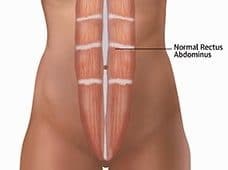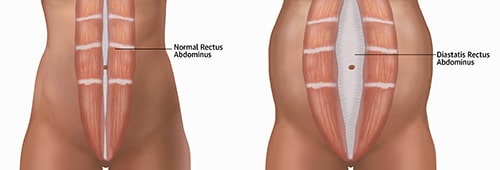
Pregnancy… one of the most exciting, rewarding, and exhausting times of your life. Your body is changing on a daily level to nurture and grow your baby. Fast forward 9 months; you have just given birth to your new beautiful child. The body that once housed a tiny human slowly starts adjusting back to “normal.” As time progresses, you are starting to see some real changes. You are starting to feel more like yourself and at 6 weeks postpartum you’ve been cleared to start exercising by your OBGYN, but something doesn’t feel right. Your body just went through monumental changes in less than a year and you are struggling with transitioning back to physical activity. You feel weak and your back is aching from hours of caring for your baby. So, where do you start? What does safe exercise look like now?
What is Diastasis Recti and How Does It Occur?
Diastasis Rectus Abdominis (DRA) occurs when the membrane joining the two sides of the rectus abdominis muscle, “six-pack muscle,” stretches, causing the muscle to separate. This can happen when the uterus increases in size during pregnancy. Expansion of the uterus can result in pressure on the abdominal muscles, especially the rectus abdominis. The tissue connecting the rectus abdominis is called the “linea alba.” When this tissue stretches due to increased pressure, it can result in diastasis recti.

www.choosept.com
What Does Diastasis Recti Feel Like? What Symptoms Can Occur?
- A separation of the rectus abdominis muscle that is visible or palpable
- A soft or “flabby” sensation in abdominal region
- Hip, pelvic, or lower back pain
- Difficulty maintaining correct posture
- Weakness in middle or lower abdominal region
- Dysfunction in the pelvic floor muscles
What Is Involved In A Diagnosis?
- A full and detailed subjective history
- Gentle abdominal palpation to assess level of separation (DRA)
- Assessment of posture
- Assessment of core and hip strength
- Assessment of overall range of motion
- Assessment of mobility
How Is Physical Therapy Helpful?
After a thorough evaluation and examination, a physical therapist will prescribe interventions based on the impairments that are currently present. The program that is implemented will be individualized and personalized to tailor your needs. The main goal of physical therapy is to return you to your prior level of function while monitoring and improving symptoms.
Some potential avenues of treatment:
- Postural awareness and control
- Stretching and flexibility exercises
- Bracing activities – gently engaging lower abdominal muscles
- Deep diaphragmatic breathing exercises
- Manual therapy techniques
- Education regarding the most appropriate exercises to perform while rehabbing from diastasis rectus abdominis
In this video, Dr. Parker demonstrates a few core exercises for diastasis rectus abdominis
Whether you are new to the mom game or you are a seasoned veteran, you deserve to feel your best after pregnancy. If you feel that you may be suffering from any of the symptoms of diastasis recti, don’t hesitate to contact a physical therapist skilled in women’s health to schedule an evaluation and begin your journey back to feeling like yourself again.
References:
Physical Therapy Guide to Diastasis Rectus Abdominis. (2019, December 27). Retrieved April 22, 2020, from https://www.choosept.com/symptomsconditionsdetail/physical-therapy-guide-to-diastasis-rectus-abdominis#HowIsItDiagnosed
Categorized as: Post surgical